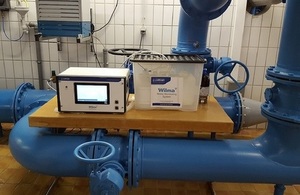New technique measures groundwater contamination
A portable system for monitoring levels of contaminated groundwater in situ is set to improve the quality and accuracy of data.

A Wilma module analysing alpha radiation in situ
Challenge
Faster, in situ monitoring of groundwater contamination in and around civil nuclear sites.
Solution
Automated liquid scintillation counting techniques and remote fluid handling.
Technology
(Wilma) On-line Water Radiation Monitor.
Benefits
Cost-effective, mobile and accurate automated system for monitoring radioactivity levels with reduced manpower requirements.
Detail
Information on conditions above and below ground is vital in the clean-up of our sites, enabling environmental requirements to be met and identifying any leaks or seepage from facilities. Current practice relies on physically taking samples from boreholes on a periodic basis followed by analysis at a lab. However, this is resource intensive and generally takes 4-8 weeks for results to be produced.
Work is under way to assess the potential of liquid scintillation counting technology, which was developed from pharmaceutical research equipment used to detect low levels of radiation in biological samples following radio-labelled drug treatment.
The technique uses a fluid ‘cocktail’ which interacts with the radioactive sample to produce measurable photons of light.
Existing principles were used to combine elements of hardware and software, producing a portable, automated system.
Mounted in a mobile enclosure, the equipment can be left in situ over a period of several weeks to collect small samples on a frequent basis, perform the analysis and record and transmit the data to a remotely located base station. This produces more frequent, accurate data on both radioactive and non-radioactive contamination, which allows trends to be identified more easily, while analysis times are faster and costs are reduced.
Status
Instrumental capabilities developed and site trial due to take place at Sellafield.
Research organisation
Innovation route
Technology from pharmaceutical industry adapted by an SME, developed and supported through a Knowledge Transfer Partnership with the University of Sheffield, followed by a feasibility study funded through an Innovate UK call co-supported by the NDA.
Updates to this page
-
Fix timestamp
-
First published.